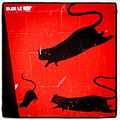Blek le Rat
Blek le Rat (* 1951 in Boulogne-Billancourt, France, civil name: Xavier Prou) is considered the forefather of stencil art (street art) in public spaces - although punks before him had already used this technique to spread their graffiti. The pseudonym is based on the French comic character Blek le Roc.
He studied graphic design and then architecture at the École des Beaux-Arts in Paris from 1971 to 1983.
Blek le Rat first started out with his friend Gérard Dumas as the artist duo BLEK. In October 1981, in the 14th arrondissement of Paris, in the Rue des Thermopyles, inspired by New York graffiti writing that Blek le Rat had seen during a trip to the United States in the early 1970s, they both first tried to spray a freehand piece, which, however, completely failed in his eyes. He then suggested making pochoirs, remembering seeing small stencil graffiti of Mussolini's head with helmet in Padua as a child on a trip to Italy with his parents. From then on he worked with this technique. His first motifs were small-format works such as rats, tanks and bananas.
Blek le Rat's artistic development was decisively influenced by David Hockney's film A Bigger Splash. Blek le Rat describes the scene in which Hockney painted the figure of one of his friends on the wall of his apartment with a brush and oil paint as the most impressive thing he had ever seen. While studying at the École des Beaux-Arts in Paris, he encountered Ernest Pignon-Ernest's posters of life-size drawings and photographs of anonymous or famous people in the 6th arrondissement (Paris), from which he drew inspiration, especially in terms of reference to place.
At the end of 1983, the duo BLEK split up and so Xavier Prou adopted the name BLEK LE RAT.
Also in 1983, he sprayed his first large-format stencil showing an old man in a peaked cap from Northern Ireland ranting at British soldiers. A photo in the French newspaper Libération served as the motif template. Many other large-format works followed, including Tom Waits, Joseph Beuys, Andy Warhol, François Mitterrand, Marcel Dassault, fauns, centaurs, Jesus Christ and various Madonnas modeled on old masters such as Michelangelo or Caravaggio, as well as a self-portrait with suitcases full of pochoirs. Blek le Rat himself says of his works, "They are my figures, they all resemble me in some way, they introduced me to the world as one person introduces himself to another. Whenever I painted them on the walls, I felt like I was leaving a part of myself on the walls of all the cities I visited." Starting in 1983, other pochoirists followed his example. The École de Blek le Rat postulated by the French newspaper Le Monde in 1987 included the pochoirists Jérome Mesnager, Marie Rouffet, Thierry Gauthé, Etherno, Epsilon, Miss.Tic and Surface Active.
In addition to his hometown of Paris, he has worked in cities such as Berlin, Cologne, Leipzig, Wiesbaden, London, New York, San Francisco, Florence, Naples, Lisbon, Buenos Aires, Marrakech and Munich.
A 1991 stencil graffito "Madonna with Child", which Blek le Rat dedicated to his great love, his current wife Sybille, was rediscovered in Leipzig in early 2012. It had been covered by posters for years. In the summer of 2012, it was restored by the artist and has since been added to Saxony's list of monuments. According to the artist, the work is the oldest surviving traces of his art.
· 
The iconic stencils of Blek le Rat rats
· 
"Ballerina" by Blek le Rat at 941 Geary Gallery, San Francisco.
· .jpg)
"Sheep" by Blek le Rat at Subliminal Projects Gallery, Los Angeles.
· .jpg)
Blek le Rat, London, 2008
.jpg)
Xavier Prou, 2011
Search within the encyclopedia